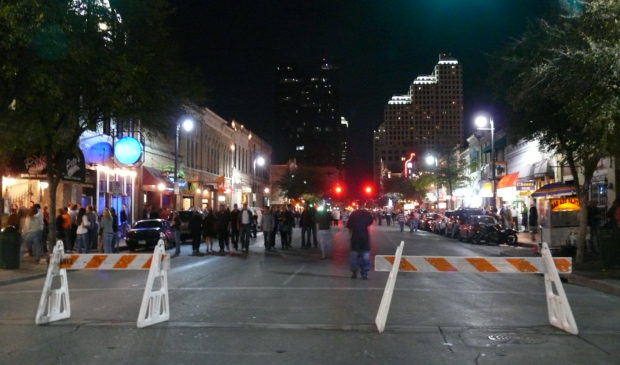City had data, but not follow-through, to ‘fix’ Sixth Street in 2014
Monday, March 7, 2022 by
Chad Swiatecki City leaders had a pair of reports nearly a decade ago that prescribed changes to make the downtown Sixth Street entertainment district safer, yet many of those actions were never implemented despite a 2014 City Council resolution that included several of them.
Last week during discussion on a resolution that advanced some of the steps included in last year’s Safer Sixth Street initiative, Council Member Kathie Tovo said she was unaware of the studies, and only learned of them in the days following last summer’s mass shooting on Sixth Street that killed one tourist and injured a dozen others.
A June 12 Facebook post from Don Pitts, former head of the city’s Music and Entertainment Division, referenced the 2013 report from crowd behavior expert Keith Still and another created by the Responsible Hospitality Institute, and attributed the inaction on the recommendations to lack of initiative by the city’s upper management. In a comment on that post, Tovo said she would query city staff on those documents, which helped to shape the first resolution last summer and last week’s follow-up.
The Still report was drafted after input sessions with more than four dozen businesses, community groups and seven city departments, including Austin Police Department, Austin Fire Department, Economic Growth and Redevelopment Services, and Austin Transportation.
The report noted the significant structural deterioration of the district as well as the frequency of overcrowding and underage drinking as some of the larger issues afflicting the area, and included creation of an entertainment business permit and improved lighting among possible solutions. The recent resolutions related to making the district safer have addressed both those ideas, as well as creating new uses for business and public spaces to add diversity of visitors and make the area active outside after-dark drinking hours.
Tovo told the Austin Monitor that the prominence of Sixth Street as a nationally known destination should have fueled more action by city staff on the resolution that was passed six months after a reckless motorist killed several pedestrians just off Sixth Street during South by Southwest.
“Given the significance of the issues, there should have been more attention given to it and there should have been a stronger response to what was there,” she said. “We’ve been talking for a long while about diversifying the uses along Sixth Street, but you can’t just will that into being. Activating new spaces is a good idea, but that too will be a challenge because you have to carve out spaces in areas that are already crowded. But the Downtown Austin Alliance Foundation has some good ideas about how we can do that.”
While the entertainment license idea stalled because of resistance from business owners and the Austin chapter of the Music Venue Alliance in 2017, Tovo said the urgency around public safety as well as significant interest in redeveloping parcels in and around the district make it imperative that the city enact some regulation to improve safety planning for nightlife spots.
“My guess is we’ll hear feedback and suggestions for refinement. My hope is there is enough will,” she said. “As I see it there’s a lot if interest in enacting these changes on Sixth Street to make it safer and I’d like to see lots of cooperation in trying something new, because we have a situation that needs to change immediately.”
Pitts, who resigned from his position in 2017 and has gone on to consult for cities such as San Antonio, Sacramento and Chattanooga on public policy around music, said city management in 2013 and 2014 were reluctant to take on the responsibility for better management of the Sixth Street district.
“Some of them thought I was crazy and asked me why I wanted to set off on a failed expedition,” he said. “We used to say Sixth Street was terrible all of the year, and it seemed like the city would just look at Sixth Street once a year with South by Southwest’s help to try to make it safer. To me, it seemed like there were misguided expectations when Council passed its resolution for city management and staff to do something and expect it would automatically be ‘all hands on deck’ for this to get done.”
Download (PDF, 2.38MB)
Photo made available through a Creative Commons license.
The Austin Monitor’s work is made possible by donations from the community. Though our reporting covers donors from time to time, we are careful to keep business and editorial efforts separate while maintaining transparency. A complete list of donors is available here, and our code of ethics is explained here.
You're a community leader
And we’re honored you look to us for serious, in-depth news. You know a strong community needs local and dedicated watchdog reporting. We’re here for you and that won’t change. Now will you take the powerful next step and support our nonprofit news organization?








